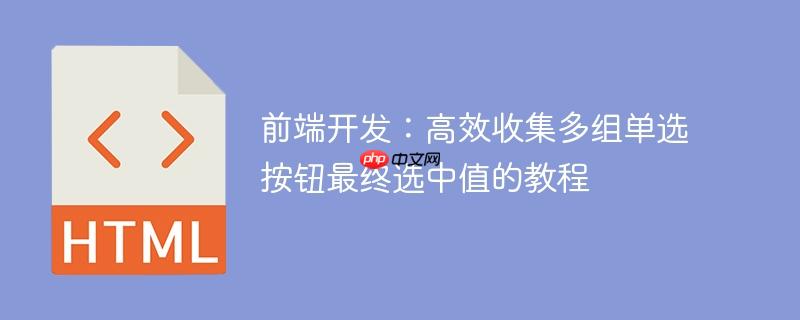
本教程详细介绍了如何在Web应用中,特别是在处理商品变体选项时,高效准确地收集用户从多个单选按钮组中最终选择的值。通过利用JavaScript的document.querySelectorAll(‘:checked’)和Array.from()方法,我们可以在用户点击提交按钮时,一次性获取所有已选中的单选按钮值,从而避免重复数据并简化后续的逻辑处理,如匹配产品变体ID。
场景分析:多组单选按钮值的收集挑战
在电商网站或其他需要用户选择多种属性的场景中,我们经常会遇到需要从多个单选按钮组(例如,t恤的“尺码”、“材质”、“颜色”)中收集用户最终选择的选项。一个常见的需求是,当用户点击“添加到购物车”或“提交”按钮时,一次性获取所有已选中的值,用于后续的逻辑处理,例如根据这些选项查找对应的产品变体id。
然而,在实现这一功能时,开发者可能会遇到一个挑战:如果为每个单选按钮添加onclick事件来收集值,当用户更改选择时(例如,从“小号”改为“中号”),旧的选择和新的选择都可能被记录,导致数据冗余和不准确。我们真正需要的是用户在提交前,对每个组做出的最终选择。
常见误区及问题
许多开发者可能会尝试在每个单选按钮被点击时,将其值添加到数组中。例如:
<div class="radios"> <!-- ... 省略其他html ... --> <script> var optionsArray = []; document.querySelector('.radios').addEventListener('click', function(e) { // 这种方式会导致重复添加,且无法区分最终选择 if (e.target.type === 'radio') { optionsArray.push(e.target.value); console.log(optionsArray); // 输出可能包含旧值和新值 } }); </script> </div>
这种方法的问题在于:
- 数据冗余: 每次用户更改选择,新的值会被添加,而旧的值并不会被移除,导致数组中包含多个属于同一组的选项。
- 逻辑复杂: 需要额外的逻辑来过滤掉旧值,确保每个组只有一个值,这增加了代码的复杂性。
解决方案:在提交时一次性收集最终值
为了避免上述问题,最有效的方法是仅在用户点击“添加到购物车”或“提交”按钮时,才去收集所有单选按钮组中当前被选中的值。这样可以确保我们获取的是用户最终的、确定的选择。
立即学习“前端免费学习笔记(深入)”;
核心思路是利用JavaScript的dom查询方法,查找所有类型为radio且处于:checked状态的输入元素。
关键JavaScript代码
// 获取所有当前被选中的单选按钮 const checkedRadios = document.querySelectorAll('input[type="radio"]:checked'); // 将nodeList转换为数组,并提取每个选中单选按钮的值 const radio_values = Array.from(checkedRadios, radio => radio.value); // 此时 radio_values 数组将包含所有不同组中唯一被选中的值 console.log(radio_values);
代码详解
-
document.querySelectorAll(‘input[type=”radio”]:checked’):
-
Array.from(checkedRadios, radio => radio.value):
完整示例与集成
下面是一个结合了HTML结构和JavaScript逻辑的完整示例,演示如何在点击“添加到购物车”按钮时收集这些值:
<!DOCTYPE html> <html lang="zh-CN"> <head> <meta charset="UTF-8"> <meta name="viewport" content="width=device-width, initial-scale=1.0"> <title>收集多组单选按钮值</title> <style> body { font-family: Arial, sans-serif; margin: 20px; } .product-options { margin-bottom: 20px; border: 1px solid #eee; padding: 15px; border-radius: 5px; } .option-group { margin-bottom: 15px; } .option-group p { font-weight: bold; margin-bottom: 5px; } .option-group label { margin-right: 15px; cursor: pointer; } button { padding: 10px 20px; background-color: #007bff; color: white; border: none; border-radius: 5px; cursor: pointer; font-size: 16px; } button:hover { background-color: #0056b3; } #result { margin-top: 20px; padding: 10px; background-color: #f8f9fa; border: 1px solid #dee2e6; border-radius: 5px; } </style> </head> <body> <h1>产品变体选择</h1> <div class="product-options"> <div class="option-group"> <p>尺码:</p> <input type="radio" id="size-s" name="size" value="S"> <label for="size-s">S</label> <input type="radio" id="size-m" name="size" value="M" checked> <label for="size-m">M</label> <input type="radio" id="size-l" name="size" value="L"> <label for="size-l">L</label> </div> <div class="option-group"> <p>颜色:</p> <input type="radio" id="color-red" name="color" value="Red"> <label for="color-red">红色</label> <input type="radio" id="color-blue" name="color" value="Blue" checked> <label for="color-blue">蓝色</label> <input type="radio" id="color-green" name="color" value="Green"> <label for="color-green">绿色</label> </div> <div class="option-group"> <p>材质:</p> <input type="radio" id="material-cotton" name="material" value="Cotton"> <label for="material-cotton">棉</label> <input type="radio" id="material-silk" name="material" value="Silk" checked> <label for="material-silk">丝绸</label> <input type="radio" id="material-polyester" name="material" value="Polyester"> <label for="material-polyester">涤纶</label> </div> </div> <button id="addToCartBtn">添加到购物车</button> <div id="result"> <p>当前选中的选项:</p> <pre id="selectedOptions"></pre> </div> <script> document.addEventListener('DOMContentLoaded', function() { const addToCartBtn = document.getElementById('addToCartBtn'); const selectedOptionsDisplay = document.getElementById('selectedOptions'); addToCartBtn.addEventListener('click', function() { // 1. 获取所有被选中的单选按钮 const checkedRadios = document.querySelectorAll('input[type="radio"]:checked'); // 2. 提取这些单选按钮的值到一个数组中 const radioValues = Array.from(checkedRadios, radio => radio.value); // 3. 在控制台和页面上显示结果 console.log('用户最终选择的选项:', radioValues); selectedOptionsDisplay.textContent = JSON.stringify(radioValues, null, 2); // 4. 后续逻辑:例如,根据这些值查找产品变体ID // 假设有一个 variantsArray 存储了所有变体信息 // for (let i = 0; i < variantsArray.Length; i++) { // // 比较 radioValues 与 variantsArray[i].options // // 注意:比较数组需要确保顺序一致或进行排序后比较 // if (json.stringify(radioValues.sort()) === JSON.stringify(variantsArray[i].options.sort())) { // console.log('匹配到变体ID:', variantsArray[i].id); // // 更新隐藏输入框的值,准备提交 // // document.querySelector('#add-cart').value = variantsArray[i].id; // break; // } // } // 实际应用中,你可能还会有一个隐藏的表单字段来存储这个ID, // 并在表单提交时发送到后端。 }); }); </script> </body> </html>
注意事项
- name 属性的重要性: 确保每个单选按钮组都有一个唯一的 name 属性。这是浏览器识别单选按钮组并确保同一组中只有一个按钮可以被选中的关键。
- 默认选中: 可以在HTML中通过添加 checked 属性来设置默认选中的选项,如示例中的size-m、color-blue、material-silk。
- 数组比较: 如果需要将收集到的选项数组与后端返回的变体选项数组进行比较(例如,[‘M’, ‘Blue’, ‘Cotton’]),请确保比较方式是可靠的。直接使用 JSON.stringify() 比较数组可能因为元素顺序不同而失败。更好的做法是先对两个数组进行排序,然后再进行字符串化比较,或者使用更复杂的数组元素匹配逻辑。
- 用户体验: 考虑在用户没有选择所有必选选项时提供反馈。在 addToCartBtn 的点击事件中,可以检查 radioValues.length 是否等于期望的选项组数量。
总结
通过将单选按钮值的收集逻辑绑定到“提交”或“添加到购物车”按钮的点击事件上,并利用 document.querySelectorAll(‘input[type=”radio”]:checked’) 和 Array.from() 方法,我们可以高效、准确地获取用户在多个单选按钮组中的最终选择。这种方法避免了在每个单选按钮点击时进行复杂的过滤和去重操作,使代码更简洁、逻辑更清晰,从而提升了开发效率和用户体验。


评论(已关闭)
评论已关闭